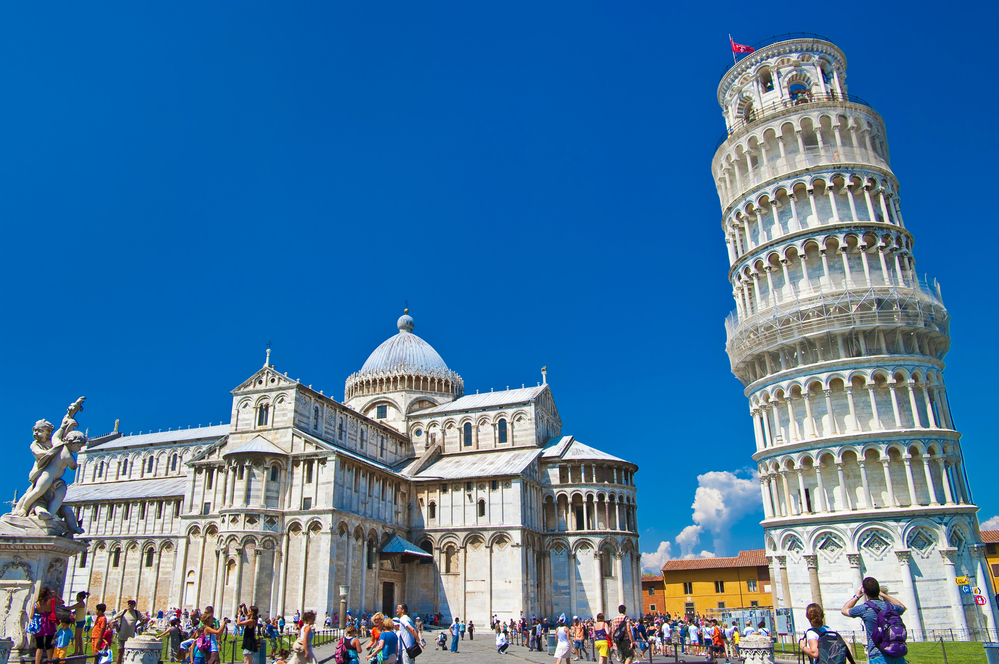Recently I had the occasion to visit Pisa in Italy. It was out of season and a professional tour guide friend had said she’d show me the Campo dei Miracoli and the famous Leaning Tower. I wasn’t dissapointed. As sights go, the Leaning Tower of Pisa is like an A-list celebrity. Everyone knows what it looks like before they even see it. But despite all the postcard images and the hype, i can tell you that standing in front of it leaves you genuinely starstruck.
The Leaning Tower of Pisa is part of the Campo dei Miracoli, or “Square of Miracles”. A complex of buildings that blazes white on a field of green grass. Once you tear your eyes away from the Leaning Tower, you slowly realise just how remarkable all of the buildings in the complex are. The baptistery, the cathedral, and its bell tower all seem to demand your attention.
This is something that the city fathers very much intended. In 1063, the Pisans attacked the city of Palermo in Sicily and returned with their ships’ holds full of riches. They used the spoils to built the cathedral complex as a show of importance. The complex was intended as a kind of architectural publicity stunt on an enormous scale. And after the cathedral was enlarged it was the largest of its kind for a century.
The layout of the buildings has a deeper significance than is at first obvious. They are placed in a specific order, to mirror the journey of life: from baptism, into the christian life and eventually on to death.
But though the baptistery and the cathedral are a delight to behold – its the Leaning Tower that is the straight-up winner for tourists. Tilting at an angle of 5 degrees off perpendicular, this tower is roughly 55 metres high and weighs in at 14,500 tonnes.
You might be wondering if it has always leaned in this way. And the answer is yes. When construction of the tower began in 1173 the architect realised it was leaning after only three of the eight tiers were finished. Trying to correct this, he took the unusual step of making the subsequent tiers shorter on one side. (Look closely and you’ll see that the layers of the tower are shorter on one side giving it a curved appearance.) Over the last 800 years the tower has been “falling” by 2mm every year, a result of the shifting soil that’s full of clay sand and shells.
Everything has been done to try to straighten the tower, from draining the foundations to excavating one side, to filling in the foundations with concrete. Experts claim that the latest 11 year project seems to have halted the leaning.
Of course this “tilt” doesn’t stop tourists wanting to go up to the top of the tower. But for the eye-watering fee of €18, and the 251 steps to get to the top, you may be happy appreciating the view from down below.
Interestingly few Pisans make the journey themselves. Many of them have an inherited superstition about going up the tower. The legend goes that it brings misfortune to any local who climbs to the top. Fortunately this didn’t stop Galileo, a son of the city who supposedly went up the tower in an attempt to prove a theory. Legend has it he dropped two spheres of different masses from the top of the tower, trying to demonstrate that their times of descent were independent of their mass. Strange to think that a badly planned piece of engineering was responsible for proving an essential piece of physics.
Its beauty is beyond doubt – something which saved its life during the war. A certain American GI named Leon Weckstein was tasked with discovering if the tower was being used as an observation point by the Germans during the war. His orders were to inform his superiors if he saw the enemy on the tower and report it. On his command, the tower would then have been obliterated from the air. In his story, he recounts how he stared at the tower for some time, and though he was sure it was being used by the enemy, he was unable to give the order because he was so overcome by the beauty of the tower.
The appeal of the Leaning Tower of Pisa is universal. An example of perfect imperfection. For more about the Leaning Tower and tips on what else you can do while you’re in Pisa, head over to lovefromtuscany.com
Ben Carson and Sabrina Nesi are both travel writers based in Florence, and co-founders of the website lovefromtuscany.com, an insider’s travel guide to Tuscany. Here they share their knowledge, and pour out all their passion for the art, culture, lifestyle and food of the region. They’re always looking for new stories to tell and hidden corners to explore. You can connect with them on Facebook, Twitter and Instagram and read their blog at lovefromtuscany.com/blog






























